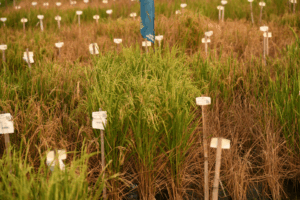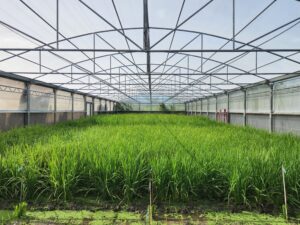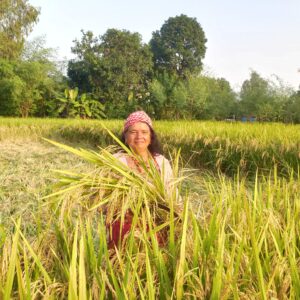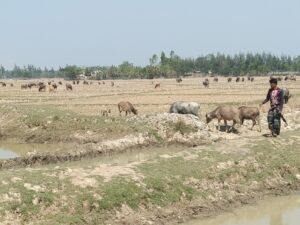Most of the studies in EIGP were conducted on zero-tillage based on a single crop in rice-wheat production system. The present study was focused to identify the suitable tillage and crop establishment practice to improve the productivity and profitability of rice-wheat-greengram system. We hypothesized that CA-based tillage and crop establishment methods would improve crop yields, water productivity, net income, and energy efficiency; and reduce the environmental footprint.
Rice-wheat cropping system (RWCS) is the largest agricultural production system, extended over nearly 14 million ha in the Indo-Gangetic Plains (IGP) of South Asia. Although RWCS is vital for ensuring future food security and livelihood of millions of people in South Asia, the path to success has been affected by declining soil health, groundwater resources, monocropping of cereal-cereal system, increasing climate variabilities, and changing socio-economic dynamics.
At present in RWCS, most of the rice area in EIGP is covered by long-duration (150–160 days) paddy varieties coupled with late transplanting. Late harvesting of rice and longer turnaround period results in delayed wheat sowing with lower yield and quality due to terminal heat stress during grain filling. There is also an average yield loss of 27 kg/ha/day with delay in wheat planting beyond November 15.
With increased use of combined machines for harvesting rice and wheat in the region, large amount of crop residue is left in the fields. According to one estimate, RWCS alone contributes ~33 % of the total crop residue (~ 620 million tons) generated every year in the Indian IGP. Management of the loose and scattered rice residue after combined harvest is a major challenge as it obstructs the tillage operations and seeding of succeeding wheat crop.
In order to clean the fields for sowing of wheat after rice, further greengram after wheat harvest, local farmers quickly burn the left-over rice/wheat residue, which is becoming a common inexpensive phenomenon in EIGP. It has been estimated that burning of one ton of rice residue accounts for a loss of 5.5 kg N, 2.3 kg P, 25 kg K and 1.2 kg S besides, organic carbon.
Crop residue burning results in environmental pollution including greenhouse gas (GHG) emission, loss of earthworms/microbial population, lowering of soil nutrients and organic humus content in the top soil, which in long run reduces the soil fertility and sustainability. Stopping crop residue burning will not only counteract the GHG emission but can also improve soil health when incorporated into the soil.
Conservation Agriculture (CA)-based management paradigm (i.e., minimal soil movement, retaining crop residue cover on soil surface, and use of diversified crop rotation) adopted by the farmers in South Asia has prompted scientists to revisit and provide solutions to many emerging challenges.
The CA practices and cropping systems followed elsewhere are diverse than those adopted in the EIGP. While puddling and transplanting are popular in rice, zero tillage (ZT) with or without crop residue retention is practiced in succeeding winter crops indicating that the protocols of CA are partially adopted in the EIGP.
The beneficial effects of CA are largely attributed to the permanent crop residue cover on the soil surface. The positive effects of crop residue depend upon its quantity, quality, and placement. The adoption of CA not only provides extra inputs of nutrients but also prevents its loss from local ecosystem. New facts about gradual N-release from legume residue are even more compelling.
The efficiency of a ZT production system depends on the amount and distribution of plant residue left on soil surface. ZT with residue retention offers a yield advantage of 5.8 %, improved water use efficiency by 12.6 %, an increase in net income of 25.9 %, and a reduction of 12.33 % in global warming potential.
Despite several benefits, there is a slow adoption rate of ZT in the EIGP because of the limited access to required inputs (seeding machinery, herbicides, etc.), and old mindset of farmers. The vulnerability of smallholder subsistence farmers to global climate change is expected more with rice yields projected to reduce about 3.2–22 % with an increase in air temperature by the end of this century as per simulated model.
It has been estimated that climate change may likely reduce the rice-wheat system productivity by about 4 % under farmers’ practice across eastern IGP. As the average temperature in this region rises, early sowing of wheat using resource conservation technologies (RCTs) will become even more important.
It is not enough to increase the yield of RWCS, a third crop must be offered to the smallholders of EIGP for achieving a 300 % cropping intensity. The time saving through CA-based interventions will facilitate early wheat sowing and the timely sowing of greengram in succession. Inclusion of grain legumes into crop sequences helps in the accumulation of soil carbon and nitrogen, and reduces soil CO2 emission under ZT production system.
Diversification of rice-wheat cropping system with greengram would not only improve the soil health and farm income, but also reduce the water use and increase the adaptability to heat and water stress.
New facts and crop establishment (CE) methods may shift the economic fundamentals in favour of sustainable intensification of RWCS. Some CE methods including zero-tillage with crop residue retention on the soil surface, mechanical rice transplanting, system of rice intensification (SRI), and DSR have their strengths and weaknesses.
Considering all these, triple zero-till cropping (ZT DSR-ZT wheat-ZT greengram) under the irrigated agro-ecosystem of EIGP may emerge as more sustainable RWCS for smallholder farmers. Most of the studies in EIGP were conducted on zero-tillage based on a single crop in rice-wheat production system.
Hence, the present study was focused to identify the suitable tillage and crop establishment practice to improve the productivity and profitability of rice-wheatgreengram system. In addition, some important CA-based parameters like energy use, and how efficient use of energy can help to reduce the environmental footprints.
To address the issues of declining productivity and profitability, deteriorating soil health, water scarcity, labour shortage, and climate change etc., CA-based crop management practices are being developed and popularized in the IGP of South Asia. However, most of the CA technologies are confined to ZT-wheat in ricewheat system with partial or no crop residue retention in EIGP, lacking system’s approach and crop diversification.
The present study clearly demonstrates that shifting from conventional system to an intensified CA-based approach in RWCS can reduce the cost of production with similar or higher yields, and improve water productivity and profitability. The current study also suggests that the CA-based system was more energy-efficient and eco-friendly with lower system global warming potential.
The information generated from this study would enhance the knowledge and strengthen the database of policymakers and researchers for promoting safer, cleaner, sustainable as well as productive climate-resilient cropping systems in the IGP of South Asia to achieve the Sustainable Development Goals.
More long-term studies under varying soil types and management would be beneficial in order to increase the impact and large-scale adoption of these technologies in the EIGP.
Read the study:
Mishra JS, Poonia SP, Kumar R, Dubey R, Kumar V et al. (2021) An impact of agronomic practices of sustainable rice-wheat crop intensification on food security, economic adaptability, and environmental mitigation across eastern Indo-Gangetic Plains. Field Crops Research Volume 267






